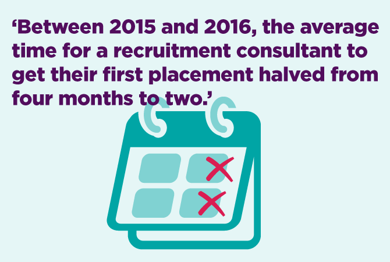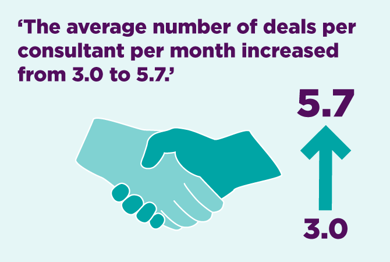The situation
When Melissa Venner* started as L&D Manager at Liquid Personnel, she knew the first person she’d need to develop was herself. 'I'd realised in my previous role that I really enjoyed helping others succeed, but I hadn't actually worked in L&D,' she recalls. 'I'm a scientist by training too, so I wanted to back up my passion for the topic with reference models and evidence – not just anecdotes.'
Founded in 2006, Liquid Personnel is the UK’s largest supplier of agency social workers, with a turnover of more than £101m (2017).
Its base in Manchester's vibrant Northern Quarter helps it to attract young recruits into its sales and support roles. But with lots of agencies chasing the same candidates, and paying the same rates, competition is tough. And candidates often choose an agency based on which consultant they prefer.
*(Melissa Venner now works for Core Talent Recruitment)
Our L&D differentiates us massively when attracting and keeping candidates. We used to accept that some new starter attrition was unavoidable; now we expect everyone to pass probation.
THE CHALLENGE
This means that, as Stuart says, ‘The people are the number one thing.’ But when Mel joined the company, staff attrition was on the rise. And exit interviews showed that a lack of training and progression were common areas of dissatisfaction.
At the time, there was some basic sales training in place, but managers had no input into it. And there was nothing for support staff. As a result, enthusiasm for L&D was low.
The solution
Mel spent a year studying for the CIPD’s Intermediate Diploma in L&D, applying what she learned along the way. (For example, to build the business case for developing new programmes.)
She held focus groups with managers and directors to find out the skills their people needed. She then designed and gathered feedback, first on a skeleton structure, then on more detailed course content. And she made changes to reflect what she heard. Finally, she developed an e-learning strategy to support the face-to-face courses.
Getting buy-in wasn’t always simple. Mel wanted to expand and upskill the company’s approved training consultants (ATCs), so every corner of the business had ambassadors who could transform how and when people learned. This meant convincing people to become ATCs on top of their day jobs. And it meant having to justify paying those people a day rate as well as their salaries. The CIPD Diploma helped Mel to effectively communicate the value of her plans to stakeholders.
The results
Training is now transformed at Liquid Personnel. Along with two foundation courses – one for sales people and one for the support staff – there are two 'progression' courses for people with more experience. In total, this means new starters have 2.5 years of engaging, effective and measurable training. Liquid Personnel was also one of a handful of companies accredited by the Recruitment and Employment Confederation (REC) to award its Certificate in Recruitment Practice. Its pass rate was 100%.
Supporting the face-to-face training are short e-learning courses, which employees can take through the Litmos Heroes app. In the three months, 300 courses were taken voluntarily.

But perhaps the biggest shift is that responsibility for training now sits with the ATCs in the business, not with the L&D team. This has led to a culture of informal learning, where people ask each other questions and take part in master classes at lunchtimes. Mel’s particularly proud that everyone who’s been an ATC has had a promotion within six months – making the role incredibly sought-after. One ATC even decided to join her in L&D.
The impact on the business has been huge, too. Retention and engagement are up, and new starters increasingly cite the training as a reason for deciding to join. As Maddie Blazeby, principal recruitment consultant and ATC, says: ‘The ethos is, “We’re here to help you get where you want to be”. So you don’t need to look elsewhere.’
Between 2015 and 2016, the average time for a recruitment consultant to get their first placement halved from four months to two. The average number of deals per consultant per month went from three to 5.7. And staff turnover dropped by 18%.

Top tips
For Stuart, you just need to look at the cost of unsuccessful hires to see the business case for L&D. ‘It’s a no-brainer,’ he says. ‘Great training and progression are the way to succeed and grow.’
To replicate Liquid Personnel’s success, Mel recommends spending time gathering as much information as you can. ‘Before you even start to think of a solution to your challenge, speak to all your peers and colleagues,’ she says. ‘Everything will be much easier from then on.’
Add a sprinkle of gold dust in the form of Mel’s passion for L&D, and you might just have a winning formula.
CIPD Trust
Tackling barriers to work today whilst creating inclusive workplaces of tomorrow.
Bullying
and harassment
Discover our practice guidance and recommendations to tackle bullying and harassment in the workplace.

Explore the many rewards of working in the people profession

Explore career areas within the people profession, and the typical activities you may find yourself doing

Information and guidance to help you excel in your role, transition into the profession, and manage a career break

If you’re looking for a career in HR, L&D or any other aspect of the people profession, there’s a route that’ll suit you
Read the CIPD’s November 2023 submission to His Majesty’s Treasury
